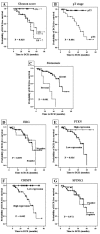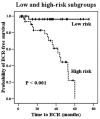Prognostic value of ERG, PTEN, CRISP3 and SPINK1 in predicting biochemical recurrence in prostate cancer
- PMID: 27284364
- PMCID: PMC4887942
- DOI: 10.3892/ol.2016.4459
Prognostic value of ERG, PTEN, CRISP3 and SPINK1 in predicting biochemical recurrence in prostate cancer
Abstract
The established prognostic factors associated with prostatic adenocarcinoma are the Gleason score, pathological T staging and serum prostatic-specific antigen (PSA) level. However, these prognostic factors alone are not sufficient for predicting prognostic characteristics, including early stage or advanced prostate cancer, presence of metastasis or disease-related mortality. The purpose of the present study was to simultaneously evaluate the prognostic value and associations of four biomarkers, namely, transcriptional regulator ERG (ERG), phosphatase and tensin homolog (PTEN), cysteine-rich secretory protein 3 (CRISP3) and serine protease inhibitor Kazal type I (SPINK1), and to conduct risk stratification of prostate cancer for use in patient management. A total of 68 formalin-fixed, paraffin-embedded, prostate cancer samples from radical prostatectomies were obtained in the Kyung Hee University Hospital (Seoul, Korea) and were studied immunohistochemically for ERG, PTEN, CRISP3 and SPINK1 to determine the proportion and intensity of staining. SPINK1 expression was mutually exclusive of ERG expression (P=0.001). The loss of PTEN and high CRISP3 expression are unfavorable indicators for prostate cancer, as PTEN loss was associated with shorter biochemical recurrence (BCR) (P=0.039), and high CRISP3 expression was associated with increased BCR (P<0.001) and cancer-related mortalities (P=0.011). Using the combination of low PTEN and high CRISP3 expression enables attention to be focused on patients who exhibit a poor prognosis. Subgrouping of patients, into high-risk and low-risk categories, was correlated with BCR-free survival in prostate cancer upon multivariate analysis (P=0.030). Overall, low PTEN and high CRISP3 expression significantly characterize the subgroups of prostate cancer that have a poor prognosis for BCR.
Keywords: cysteine-rich secretory protein 3; phosphatase and tensin homolog; prostate cancer; serine protease inhibitor Kazal type I; transcriptional regulator ERG.
Figures



References
-
- Lee K, Chae JY, Kwak C, Ku JH, Moon KC. TMPRSS2-ERG gene fusion and clinicopathologic characteristics of Korean prostate cancer patients. Urology. 2010;76:1268.e7–1268.e13. - PubMed
LinkOut - more resources
Full Text Sources
Other Literature Sources
Research Materials
Miscellaneous
